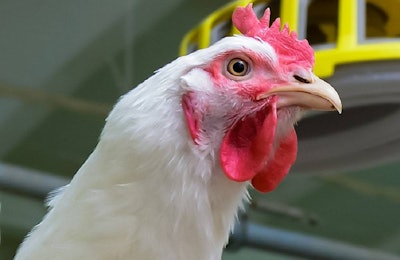
Changes in the way broilers are being produced are bringing about new challenges and exacerbating old ones related to bird health, animal welfare and regulations.
Coccidiosis and antibiotic use were listed as the two top challenges for broiler companies in 2018, according to the 2018 American Veterinarians in Broiler Production (AVBP) yearly survey, which asked the production veterinarian members to rank the top disease and non-disease issues they are facing and indicate the level of importance to their company. This data was presented by Dr. Mark Burleson, president, AVBP, and director of veterinary services, Wayne Farms, at the Delmarva Poultry Industry's 2018 National Meeting on Poultry Health, Processing and Live Production on October 9.
Significance of disease issues
When asked to rank the order of significance of diseases facing their company, for the third year in a row, respondents ranked coccidiosis as the top issue. According to Burleson, this is due to the shift away from using ionophores to control the disease with a lack of new options. Ranked second, necrotic enteritis also remains a challenge for broiler producers. He said this can partially be attributed to the lack of coccidiosis control, but also is due to the removal of antibiotics. Removal of antibiotics in the hatchery is also to blame for issues with chick quality and mortality, which respondents listed as their third most significant disease-related issue.

Dr. Mark Burleson | Photo by Alyssa Conway
“If you rip off a band-aid and you’re not ready for it, it’s probably going to hurt. So, if your hatchery and your breeders are not ready for that removal of hatchery antibiotics, that will be a pretty painful move,” he said.
Ranked fourth was infectious bronchitis, due to variant viruses causing problems or vaccines that are mostly good but can cause a few issues, said Burleson. Infectious laryngotracheitis was ranked fifth, and he noted this was mostly a problem for veterinarians operating in states where this is a yearly event.
Others ranked on the list were gangrenous dermatitis, novel reovirus and bacterial osteomyelitis of the legs, respectively, followed by avian influenza, which Burleson said will likely always be a concern but fell a couple slots from 2017 due to fewer detections than in previous years. On the other hand, histomoniasis rose three spots from 2017; Burleson advised watching for this disease because there are no proven preventatives and few treatment options.
Importance of disease challenges and opportunities to solve them
Production veterinarians who responded to the survey also ranked coccidiosis and necrotic enteritis as the most important disease challenges facing their companies. Due to the continuing move away from using antibiotics and no new products coming to market in the near term, Burleson said this means companies have to find a new or better way to do things and work with the products they currently have.
Chick quality was ranked as the second most important issue, leaving room for more research in egg sanitation and in ovo improvements.
For laryngotracheitis, ranked third in terms of importance, he said the industry needs better vaccine options to solve this challenge. To solve the issue of bronchitis, ranked fourth, Burleson suggested new technology targeting cross protection against multiple serotypes. Reovirus and dermatitis were ranked fifth in importance. Burleson also noted that avian influenza remains an important concern to the industry, opening the door for more research targeting prevention and eradication.
Significance of non-disease issues to poultry veterinarians
Topping the list of non-disease issues facing broiler production veterinarians in 2018 was the restricted use of antibiotics, driven by customer and media concerns. In a close second place was increased food safety regulations by the U.S. Department of Agriculture (USDA), mainly related to concerns over Salmonella. Biosecurity remains a significant issue, followed by poultry welfare. Vaccine availability jumped to fifth, due to a supply shortage and the fact that it takes a long time for new products to hit the market. Burleson also pointed out that meat quality issues, ranked second in 2017, dropped to number eight, which he speculated was due to implementing better management practices and fewer food safety incidences.
How to solve important non-disease challenges
In terms of importance, Burleson said Salmonella food safety regulations by far are the most important non-disease challenge facing broiler production veterinarians.
This leaves much opportunity for research and development related to the non-disease challenges respondents listed of importance to them.
To solve the Salmonella challenge, Burleson suggested using new nanotechnologies to better manage Salmonella in the field, as well as placing a renewed emphasis on serotypes versus prevalence.
To address biosecurity concerns, he said in the industry needs to find a more effective way to educate the people in the field who are actually implementing the programs.
“For poultry welfare, let’s get back to sound science, rather than what feels good or looks good,” said Burleson.
Burleson also pointed to the need for better vaccine availability, whether through regulatory or manufacturing changes, and genetic or management changes to solve meat quality issues and ensure the industry is providing a quality product.















